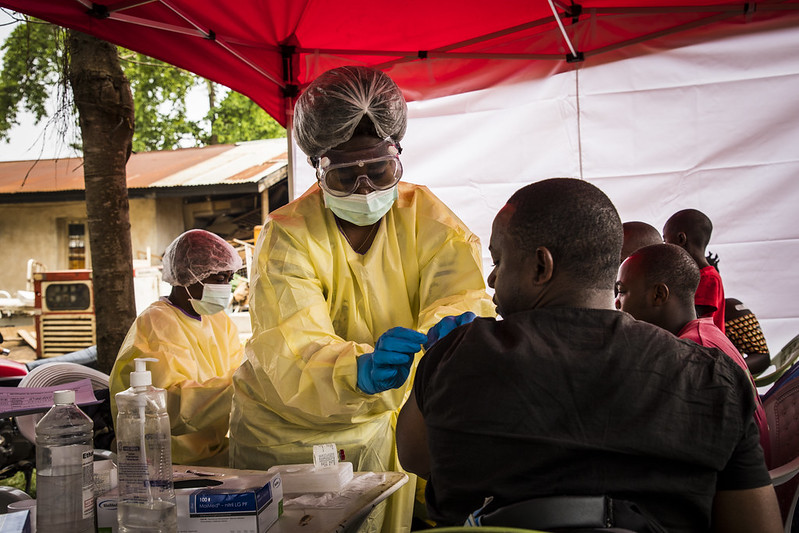How Was a Two-Year Ebola Outbreak Snuffed?
 The Ebola Virus Disease (EVD) has ravaged countries in sub-Saharan Africa since its identification in 1976. Overall, there have been 34 outbreaks of Ebola in Western Africa, 11 of which have occurred in the Democratic Republic of Congo (DRC). The largest Ebola outbreak, considered a global pandemic, lasted from 2014 to 2016. It mostly affected countries like Sierra Leone, Liberia and Guinea. At the time, a total of 11,310 deaths were reported due to the disease.
The Ebola Virus Disease (EVD) has ravaged countries in sub-Saharan Africa since its identification in 1976. Overall, there have been 34 outbreaks of Ebola in Western Africa, 11 of which have occurred in the Democratic Republic of Congo (DRC). The largest Ebola outbreak, considered a global pandemic, lasted from 2014 to 2016. It mostly affected countries like Sierra Leone, Liberia and Guinea. At the time, a total of 11,310 deaths were reported due to the disease.
The fatality rate for Ebola has ranged between 25% and 90%, depending on the severity of the outbreak and on the healthcare infrastructure of affected countries. The more modern and accessible these systems were, the more efficient the surveillance and treatment options. The second-largest outbreak of Ebola began in the Kivu region of the DRC on Aug. 1, 2018, and was only declared over as recently as June of 2020.
Containment in the DRC
Comparing the 2014 Ebola outbreak with the one that occurred in 2018 reveals a relative improvement. From 2014 to 2016, there were 28,616 EVD cases that resulted in 11,310 deaths. On the other hand, from 2018 to 2020, there were only 3,481 cases and 2,299 deaths reported.
DRC’s commendable public health response to the 2018 Ebola outbreak led to this outcome. Pre-existing infrastructural inadequacies and a lack of trust in health care officials have been the major challenges faced during Ebola occurrences. Though many of these problems continue, the better use of surveillance, contact tracing, prevention strategies and safe burial practices have greatly shaped how the most recent outbreak developed. Additionally, the global health community has made strides in vaccine development and treatment programs, making the defeat and containment of this epidemic possible.
Safe and Dignified Burials
Because the virus is transmitted through direct contact with an infected individual (living or deceased), traditional burial practices that require family members to wash the body pose a significant risk to communities during Ebola outbreaks.
In 2014, rural populations of Sierra Leone experienced surges in reported Ebola cases as a direct result of community members’ attending funerals and touching infected corpses. Since then, the CDC, the Sierra Leone Ministry of Health and Sanitation and the WHO have provided guidelines for safe protocols when handling potentially infected corpses. These protocols involve trained personnel and extensive personal protective equipment (PPE). During the recent contained Ebola outbreak, 88% of funerals utilized safe and dignified burial practices.
Vaccination Efforts
As a result of the most recent epidemic, 16,000 local responders and 1,500 WHO health workers collaborated to provide effective vaccines to 303,000 people. Individuals were considered eligible for vaccination if they had previous contact with an infected individual or were a frontline worker in an affected or at-risk area. Treatment centers, field laboratories and an Ebola national care program were also set up to care for patients, providing weekly test samples and follow-up with survivors.
EVD versus COVID-19
The world has seen other deadly viruses before COVID-19. SARS, Ebola and even the annual flu are some examples. COVID-19 stands out because it is easily spreadable and the rate of asymptomatic transmission is high. Asymptomatic transmission occurs when individuals don’t know they are infected and, as a result, spread the virus without knowing. Even though Ebola is highly contagious toward the end of the infection period, infected individuals show intense symptoms, so it is not easy for the virus to fly under the radar as COVID-19 tends to do.
Moreover, while health responses against Ebola are significant in fighting the spread of the virus, the vaccine and treatments are the real superheroes in protecting large populations and infected patients from the virus. As the world witnessed in the 2014 outbreak, Ebola left a devastating death toll in its wake without a vaccine. There are currently no viable vaccine or treatment options for the coronavirus, although development is currently in progress.
Moving Forward
Because preparedness plays a large role in within-country health responses, it is hopeful that future Ebola outbreaks will be contained. The health responses, vaccination programs and treatment options utilized by the DRC are applicable to other countries as well. Aid from WHO and other health agencies will lessen the threat of Ebola in Western Africa and the world.
– Nye Day
Photo: Flickr
